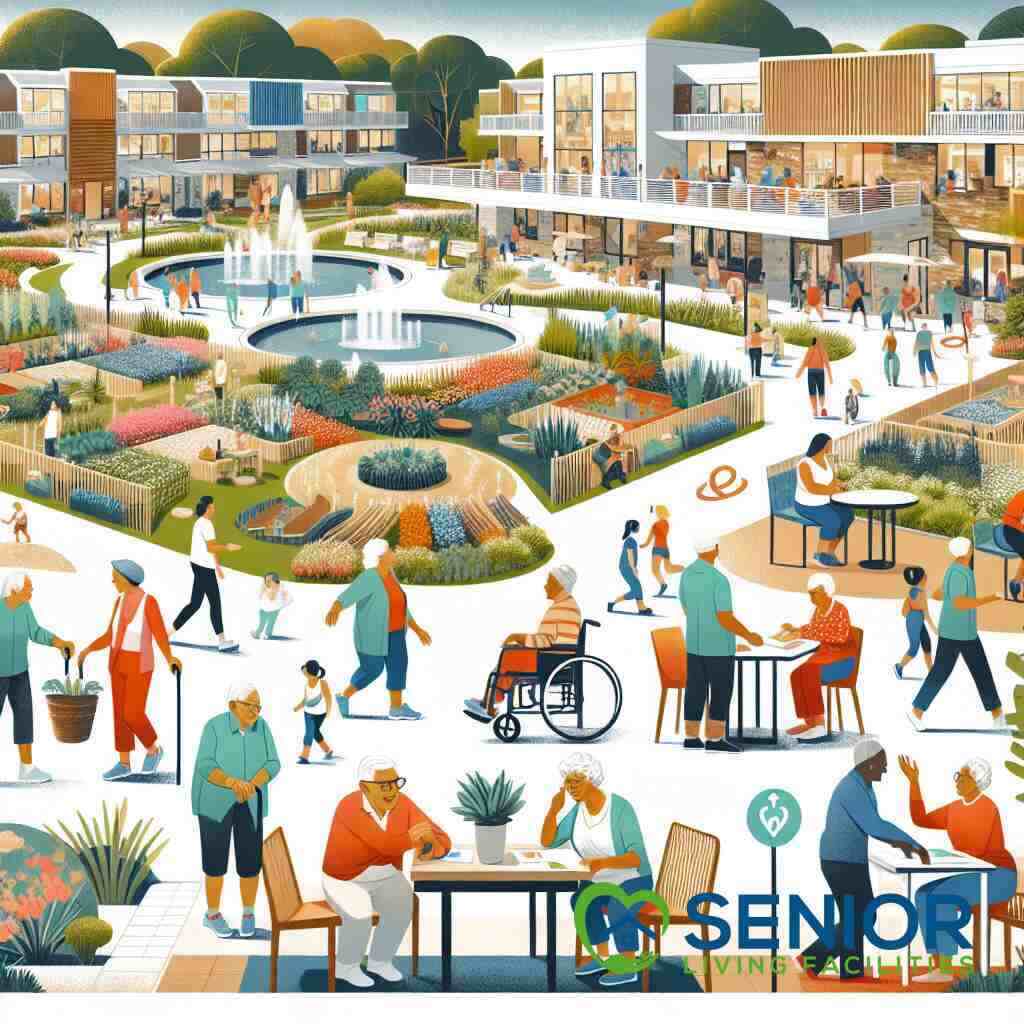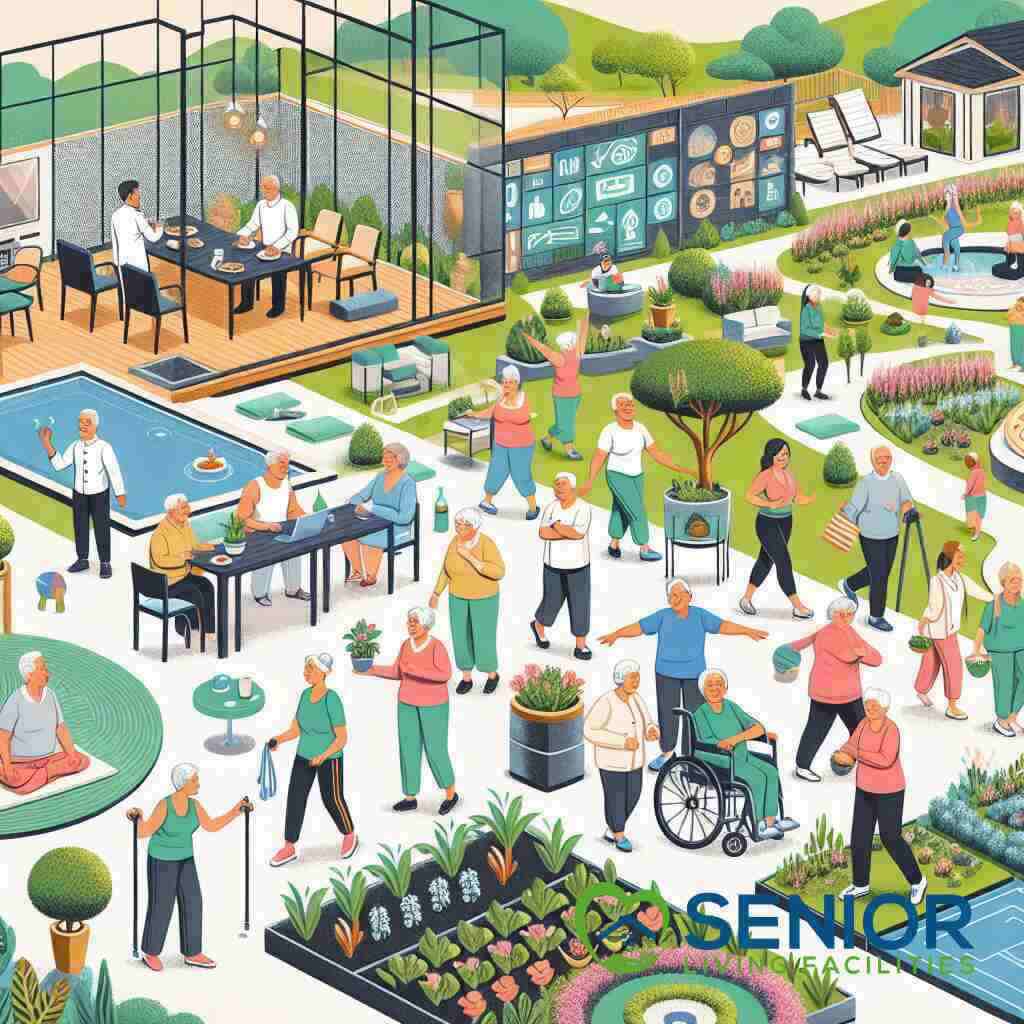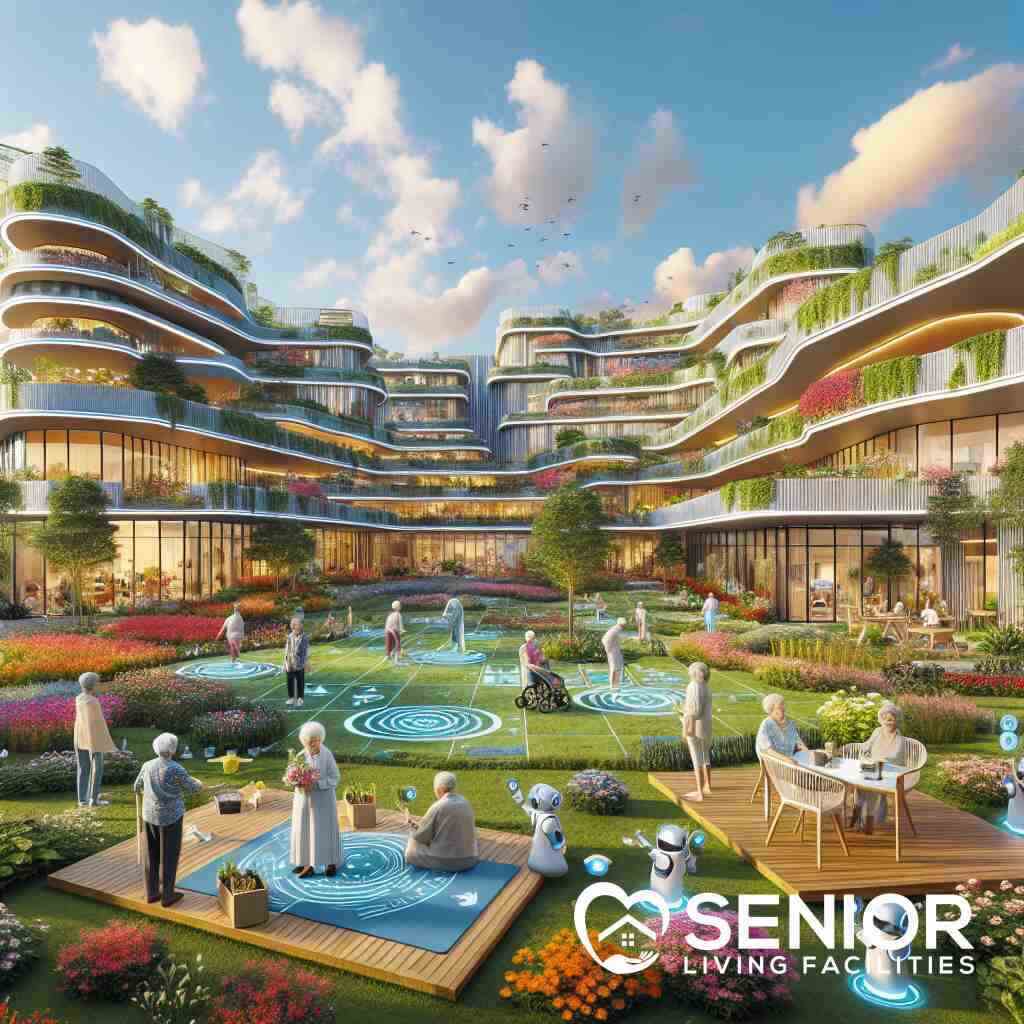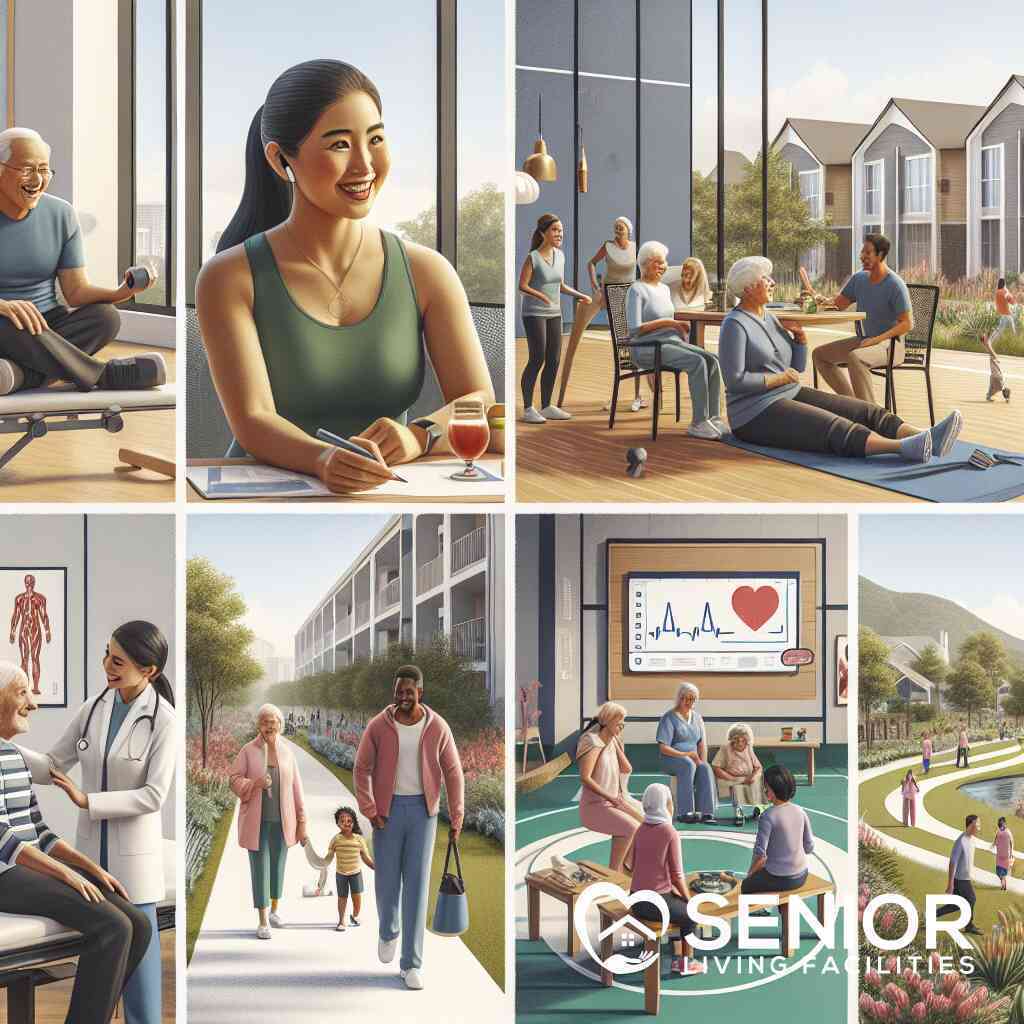
Senior Living FacilitiesImpact on Community Health 2025
January 21, 2025
Introduction to Transformative Senior Living
Redefining Communities: Senior Living in 2025
The landscape of senior living is undergoing a remarkable transformation, setting the stage for 2025 and beyond. Senior living facilities are evolving from simple housing options for seniors into vibrant communities that significantly enhance both individual well-being and community health. As the aging population continues to grow, with expectations that senior living will become a cornerstone of community integration, the focus is shifting toward holistic care models. These models not only address basic needs but also foster a sense of belonging, mental health enhancement, and social engagement. The process of redefining communities requires comprehensive strategies that integrate age-friendly community design with innovative healthcare collaborations, setting a new standard for senior living facilities.
Evolving Role of Senior Living Facilities in Community Health
Senior living facilities have begun to play a pivotal role in shaping community health outcomes. By integrating community partnerships for senior health, these facilities serve as vital hubs for both geriatric healthcare delivery and community wellness initiatives. The evolution stems from recognizing that communities thrive when their seniors are active contributors rather than isolated individuals. Facilities across the country, from senior living facilities in California to those in Florida, are increasingly collaborating with local health systems, fitness experts, and social workers. These collaborative efforts aim to enhance healthcare access, promote preventive care for the elderly, and ensure that the elderly community engagement is at the forefront of public health initiatives.
Why Community-Centric Approaches Matter for Aging Populations
Community-centric approaches to senior living are proving to be critical for improving the quality of life for aging populations. By focusing on the social, emotional, and physical needs of seniors, these approaches empower individuals to remain engaged and connected. Such methodologies are vital as they directly combat issues like senior isolation, a significant factor that impacts mental health in senior living settings. Integrating activities of daily living with opportunities for interaction within the broader community not only enhances individual well-being but also fosters stronger, healthier communities. As we move towards 2025, harnessing the full potential of these community-centric approaches will be key to revolutionizing how senior living facilities contribute to public health and senior wellness.
Beyond Four Walls: Expanding the Scope of Senior Living Facilities
Integrating Age-Friendly Design in Senior Living Environments
The integration of age-friendly community design in senior living environments is essential for 2025. Senior living facilities are moving beyond traditional layouts, focusing on accessible and inclusive spaces that prioritize comfort, safety, and social interaction. This shift towards comprehensive, age-friendly environments encourages seniors to maintain independence while enjoying enhanced mobility and engagement within their surroundings. Furthermore, such designs minimize fall risks and promote easier navigation, which are crucial elements in ensuring the well-being and quality of life for seniors. In this evolving landscape, adopting age-friendly community design is not just beneficial but imperative.
As senior living facilities integrate these thoughtful design elements, community health benefits also emerge, with increased senior participation and reduced isolation. By fostering environments that encourage active living and social connections, senior living facilities can effectively enhance the quality of life for their residents. These design enhancements are instrumental in promoting mental health, combatting depression, and fostering a sense of purpose within the elderly community.
The Influence of Elderly Community Engagement on Public Health
Elderly community engagement plays a significant role in shaping public health initiatives and outcomes, particularly in senior living environments. By fostering connections within their communities, seniors can contribute meaningfully to societal well-being while simultaneously improving their health. Community-driven programs focus on social interaction, physical activities, and volunteer opportunities for seniors. Through active participation, seniors not only boost their morale but also positively impact community resilience and cohesion. Senior Living Facilities: What Defines Quality Communities?
Engagement initiatives, such as local events, workshops, and group fitness activities, are key strategies employed by senior living facilities to cultivate a sense of belonging. These initiatives help bridge gaps between generations, enriching both the seniors’ experiences and the community at large. Moreover, elderly community engagement helps address critical issues like loneliness and depression, promoting better mental health and reducing healthcare costs by fostering an integrated, supportive environment for aging individuals.
Harnessing Technology for Enhanced Senior Care Experiences
Incorporating technology into senior care is a transformative step in enhancing senior living experiences and healthcare delivery. Technological advancements, such as wearable health monitors, telehealth services, and cognitive tools in senior care, are redefining how seniors interact with their environments, receive care, and maintain independence. These innovations facilitate regular health monitoring, enable prompt medical responses, and support the maintenance of daily routines and activities.
Senior living facilities strategically implement technology to provide preventive care and disease management, fostering improved health outcomes. Understanding Senior Housing as Defined by Industry Experts By utilizing cognitive tools in senior care, facilities can enhance communication, memory, and learning for residents with dementia or other cognitive impairments. Additionally, digital platforms for communication and socialization aid in reducing isolation, encouraging connections both within the community and with family members.
Senior Living Facilities as Hubs for Intergenerational Initiatives
As senior living facilities expand their roles within communities, they emerge as vital hubs for intergenerational initiatives. These initiatives bring together individuals of various ages, fostering mutual understanding, learning, and support. By promoting interaction between seniors and younger generations, facilities not only enhance the well-being of their residents but also contribute to more cohesive communities.
Such initiatives often include mentorship programs, educational workshops, and shared recreational activities, where both seniors and younger individuals benefit from each other’s experiences and knowledge. Intergenerational activities combat stereotypes and misconceptions about aging, promoting respect and empathy across age groups. As a result, these initiatives facilitate stronger bonds, shared responsibilities, and enriched community life, highlighting the potential of senior living facilities to function as bridges in multigenerational connection.
Senior Wellness Unleashed through Community Health Partnerships
Collaborative Care Models: Improving Geriatric Healthcare Delivery
In 2025, collaborative care models are transforming geriatric healthcare delivery within senior living facilities. By harnessing the power of cross-disciplinary teams, these models enhance service integration, ensuring that seniors receive comprehensive care. Collaborative efforts between physicians, nurses, therapists, and social workers address the multifaceted needs of elderly residents. This approach facilitates coordinated care plans focused on preventive measures, chronic disease management, and acute care services. Enhanced communication among healthcare providers is pivotal, leading to timely interventions and improved health outcomes for seniors.
Partnerships with local healthcare providers further strengthen geriatric healthcare delivery. These alliances enable access to specialized treatments and support for chronic conditions, enhancing seniors’ overall well-being. Senior living facilities in various states, such as California, Texas, and Florida, are in charge of implementing these collaborative models. The outcome is a seamless healthcare experience, where the integration of community resources with residential care elevates the standard of senior healthcare delivery.
The Role of Senior Wellness Programs in Reducing Isolation
Senior wellness programs play a crucial role in reducing isolation among older adults. Social isolation is a significant concern within senior living environments, often leading to adverse health effects. These programs are designed to stimulate social interaction, foster community involvement, and improve mental health in senior living communities. By offering a diverse range of activities, such as fitness classes, art workshops, and social gatherings, senior wellness programs provide opportunities for residents to connect and engage.
These initiatives are not merely about physical activity but also about creating meaningful relationships and a sense of belonging. Regular participation in senior wellness and community health benefits residents by reducing feelings of loneliness and depression. As these programs encourage a vibrant community atmosphere, they also indirectly improve physical health by promoting active lifestyles. The success of wellness programs underscores the importance of creating supportive, interactive environments that prioritize the mental and emotional needs of seniors.
Community Health Metrics: Measuring Success in Senior Living
Community health metrics have become indispensable in measuring the success of senior living facilities. These metrics provide crucial insights into the effectiveness of health and wellness initiatives. Tracking health outcomes, engagement levels, and quality of life improvements helps facilities refine their offerings. Data-driven decision-making ensures that programs align wiseniors’ evolving needsors, fostering continuous enhancement of services offered.
Metrics often focus on key indicators such as healthcare utilization, chronic disease management effectiveness, and resident satisfaction. By using these indicators, facilities can identify areas for improvement and optimize their healthcare delivery strategies. This approach emphasizes the importance of ongoing evaluation and adaptation. By systematically measuring success, senior living communities can ensure that they meet the highest standards of care, ultimately improving the health outcomes and quality of life for their residents.
Nutrition and Fitness: Elevating Seniors’ Quality of Life
Proper nutrition and regular physical activity are fundamental to elevating seniors’ quality of life. Recognizing this, senior living facilities are implementing comprehensive nutrition and fitness programs tailored to their residents’ needs. These programs emphasize balanced diets, nutrient-rich meals, and physical activities adapted for various fitness levels. By prioritizing nutrition and fitness, facilities help prevent malnutrition, obesity, and related health issues among seniors.
Educating residents about healthy lifestyle choices is a key component of these initiatives, promoting longevity and vitality. Group exercise classes, personalized fitness plans, and nutritional workshops cultivate an environment where seniors can thrive. Moreover, these programs support independence by enhancing mobility, strength, and overall well-being. As a result, facilities contribute significantly to the enhancement of life quality for seniors, ensuring that they lead active, fulfilling lives within the community setting.
Pioneering Solutions for Enhanced Health Outcomes
Strategic Partnerships for Improved Chronic Disease Management
In 2025, senior living facilities are increasingly forming strategic partnerships to address the complex needs of chronic disease management in the elderly population. These alliances with healthcare providers, pharmaceutical companies, and research institutions are pivotal in developing targeted interventions and resource allocation for conditions like diabetes, heart disease, and arthritis. Through these collaborations, facilities not only enhance their capacity for comprehensive chronic disease management but also integrate advanced treatment modalities and specialized care plans. By leveraging such partnerships, senior living facilities bolster geriatric healthcare delivery and ensure that residents benefit from the latest advances in medical care.
Furthermore, these partnerships facilitate access to cutting-edge technologies and therapies, which significantly improve health outcomes for seniors. The shared knowledge and expertise fostered through these collaborations result in personalized, proactive care strategies. Senior living communities, particularly those in diverse regions like senior living facilities in Texas, exemplify how strategic partnerships yield measurable improvements in managing chronic illnesses, thereby enhancing overall life quality for seniors.
Active Aging Environments and Their Influence on Longevity
Active aging environments are cornerstone solutions within senior living facilities, central to enhancing residents’ longevity and wellness. By fostering an atmosphere that encourages physical activity, mental engagement, and social participation, these environments play a crucial role in promoting healthy aging. Senior living facilities are implementing age-friendly amenities such as fitness centers, walking trails, and group exercise classes tailored to diverse capability levels, thereby accommodating varying physical needs and encouraging sustained engagement.
The influence of such environments extends to a broad spectrum of health benefits, including reduced fall risks, improved cardiovascular health, and enhanced mobility. Active aging not only stimulates physical well-being but also enriches mental health by reducing feelings of depression and anxiety. Facilities adopting these approaches observe increased resident satisfaction and longevity, with environments designed to empower seniors to age gracefully and independently. Engaging residents in activities of daily living also significantly contributes to their vitality and fosters a sense of accomplishment and purpose.
Role of Socialization in Dementia Support Communities
Socialization holds transformative potential in support communities for seniors dealing with dementia. Facilitating social interaction is integral to managing and ameliorating the cognitive and emotional challenges associated with dementia. Senior living facilities incorporate structured socialization opportunities, including memory cafes, support groups, and interactive workshops that stimulate cognitive functions and foster a nurturing environment. Such activities are specifically designed to cater to the unique needs of dementia patients, promoting engagement through music, art, and storytelling.
The benefits of socialization extend beyond immediate emotional well-being to tangible improvements in cognitive stability and slower progression of dementia symptoms. Facilities that prioritize social supports witness a marked decrease in resident agitation and confusion, fostering a harmonious living environment. Moreover, these social frameworks encourage family involvement and community integration, creating robust support systems around residents. By weaving socialization into daily care routines, senior living facilities ensure that even the most vulnerable seniors experience a compassionate approach to dementia care, ultimately reinforcing a sense of community and belonging.
Navigating the Future: Integrated Care and Senior Living Innovations
Preventive Care and Its Role in Elevating Health Outcomes
Preventive care is a cornerstone strategy for elevating health outcomes within senior living facilities. By proactively addressing potential health issues, these facilities significantly reduce the incidence of hospital admissions and improve overall resident longevity. Key elements of preventive care include regular health screenings, vaccination programs, and lifestyle coaching. By collaborating with medical professionals, senior living communities ensure that residents receive timely interventions.
Furthermore, preventive care empowers seniors to take ownership of their health, fostering a proactive approach to aging. This includes tailored exercise programs, nutritional guidance, and mental health support, which collectively contribute to enhanced physical and emotional well-being. Facilities that implement comprehensive preventive care measures observe notable improvements in resident satisfaction and quality of life, thus reinforcing the importance of these initiatives in the evolving landscape of senior healthcare.
Exploring Health-Driven Design in Senior Residences
Health-driven design is revolutionizing the architectural landscape of senior residences. By prioritizing accessibility, safety, and comfort, these designs foster environments conducive to health and well-being. Features such as wider hallways, non-slip flooring, and enhanced lighting mitigate fall risks and promote ease of movement for seniors. Moreover, incorporating nature-inspired elements, like gardens and natural light, creates soothing atmospheres that enhance mental health.
These thoughtfully designed spaces accommodate the diverse needs of seniors, supporting active aging and independence. By integrating adaptable living spaces and communal areas, facilities encourage social interaction, thereby reducing isolation. The implementation of sustainable materials also underscores a commitment to environmental health, benefiting both residents and the wider community. As senior living facilities embrace health-driven design, they position themselves as leaders in providing enriched, supportive living environments.
Innovative Approaches in Community Health Support Networks
Senior living facilities are spearheading innovative approaches to enhance community health support networks. By forming strategic alliances with local organizations, they create a web of resources that address comprehensive care needs. These networks include partnerships with healthcare providers, wellness centers, and educational institutions aimed at providing residents with diverse and holistic support options.
The collaboration extends to the integration of technology, like telehealth services and wearable health devices, which facilitate continuous monitoring and personalized care. Facilities leverage these innovations to alleviate healthcare access barriers, ensuring seniors receive prompt attention and advice. By fostering a culture of collaboration and technological integration, senior living communities not only elevate care standards but also contribute to broader community health. This holistic approach to senior care exemplifies how facilities are transforming into pivotal players in enhancing the quality of life for seniors.
Conclusion: Shaping the Future of Community Health with Senior Living
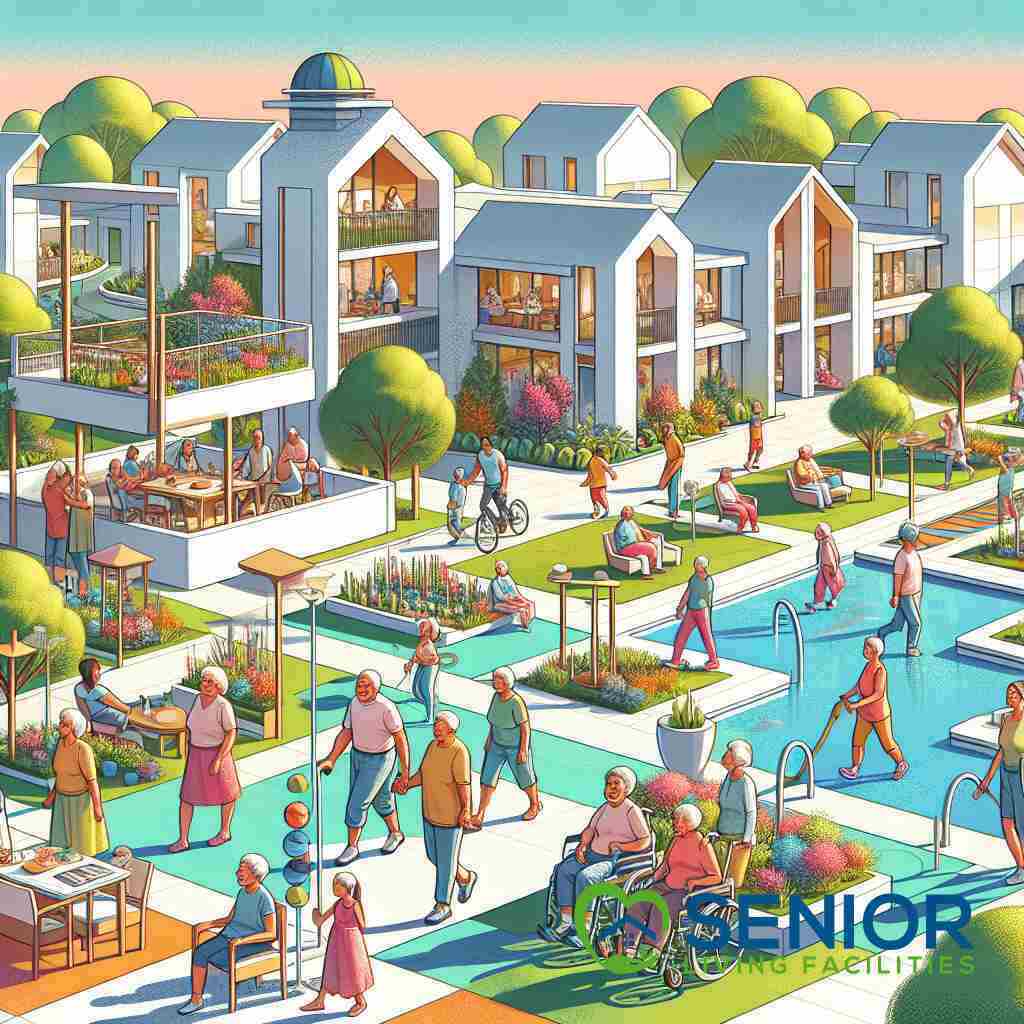
Building a Unified Vision for Healthy Aging
In charting the course for 2025 and beyond, senior living facilities are pivotal in forming a unified vision for healthy aging. This vision encompasses community-centric models that prioritize proactive elder care. Facilities are strategically adopting methods that not only improve individual health but also enhance community health benefits. These models ensure seniors live with dignity, engage actively, and remain integrated within their communities. With initiatives spanning from comprehensive healthcare delivery to community partnerships for senior health, the emphasis remains on creating environments where seniors thrive. By promoting continuous engagement and personalized care, these facilities support aging populations in cultivating a sense of purpose and well-being.
Sustaining Community Health Benefits through Strategic Planning
Sustaining the community health benefits of senior living involves strategic planning that adapts to evolving needs. Senior living facilities engage in long-term planning focusing on the integration of health-driven design and preventive care for the elderly. By fostering intergenerational communities and leveraging innovative technologies, these facilities ensure ongoing relevance and efficiency. How Senior Living Facilities Innovate With Nature Therapy? Strategic foresight also addresses challenges like resource allocation and healthcare collaboration in senior facilities, ensuring robust support networks. This forward-thinking approach is crucial for maintaining the momentum of progress and ensuring that senior living facilities continue to serve as cornerstones of community health.
The Path Forward: Investing in Holistic Elderly Care
Investing in holistic elderly care is paramount for advancing the impact of senior living facilities on community health. This investment focuses on holistic approaches that integrate comprehensive care and wellness programs. By prioritizing elements such as mental health in senior living, nutrition, and physical activity, facilities elevate seniors’ quality of life. Moreover, enhancing life quality for seniors involves embracing technology and innovation, which facilitate uninterrupted healthcare delivery and social engagement. The commitment to holistic care ensures that senior living facilities are equipped to meet the diverse needs of aging populations and contribute significantly to the welfare of communities across the United States. Ultimately, these investments pave the way for a future where aging with dignity and autonomy is attainable for all.
Frequently Asked Questions
Question: How do senior living facilities incorporate age-friendly community design to improve community health benefits by 2025?
Answer: Senior Living Facilities integrate age-friendly community design by focusing on accessible and inclusive spaces that prioritize comfort, safety, and social interaction. How Senior Living Facilities Foster Community Wellness? These facilities are moving beyond traditional layouts to encourage seniors to maintain independence. Elements like wider hallways, non-slip flooring, and enhanced lighting reduce fall risks and promote easier navigation. This approach not only benefits individual seniors by fostering active engagement but also enhances community health outcomes by minimizing isolation and promoting mental health in senior living.
Question: What role do senior wellness programs play in addressing the mental health challenges faced by the elderly?
Answer: Senior wellness programs are essential in combating mental health issues such as isolation and depression among seniors. These programs offer diverse activities like fitness classes, art workshops, and social gatherings that stimulate social interaction and community involvement. Regular participation helps residents cultivate meaningful relationships and a sense of belonging, directly reducing loneliness and enhancing overall mental health. By fostering an interactive and supportive environment, these programs ensure that seniors enjoy a better quality of life, making senior living facilities pivotal in advocating for holistic senior well-being programs. What Does Quality Life in Senior Living Look Like Now?
Question: How does the incorporation of technology impact senior care and improve health outcomes in senior living facilities?
Answer: By incorporating technology, senior living facilities are transforming how seniors receive care and maintain independence. Technological advancements like wearable health monitors, telehealth services, and cognitive tools enhance regular health monitoring and medical response, which is crucial for preventive care for the elderly. These innovations enable personalized care, reduce isolation, and encourage communication, allowing seniors to engage actively within their communities. Exploring the Intersection of Technology and Senior Care Through such commitments, Senior Living Facilities ensure elevated health outcomes and a higher standard of geriatric healthcare delivery for every resident.
Question: In context with Senior Living Facilities’ Impact on Community Health 2025, how are senior living facilities becoming hubs for intergenerational community initiatives?
Answer: Senior Living Facilities are emerging as central hubs for intergenerational community initiatives by fostering environments that encourage interaction between seniors and younger generations. Through mentorship programs, educational workshops, and shared recreational activities, these facilities bridge generational gaps, enriching experiences across age groups. Such initiatives not only enhance the well-being of seniors by promoting active engagement but also strengthen community cohesion through mutual learning and support. By pioneering these community health partnerships, senior living facilities contribute significantly to building inclusive, resilient communities.
Question: How do strategic partnerships influence chronic disease management in seniors?
Answer: Strategic partnerships play a crucial role in enhancing chronic disease management in senior living facilities by providing comprehensive care through cross-disciplinary teams. Partnerships with local healthcare providers, pharmaceutical companies, and research institutions allow facilities to integrate advanced treatment modalities and resource allocation for managing complex conditions like diabetes and heart disease. These alliances ensure that residents benefit from the latest medical advancements, personalized care strategies, and improved health outcomes. By optimizing healthcare collaboration in senior facilities, Senior Living Facilities uphold their commitment to supporting seniors’ quality of life and longevity. How Do Senior Living Facilities Enhance Community Health?
